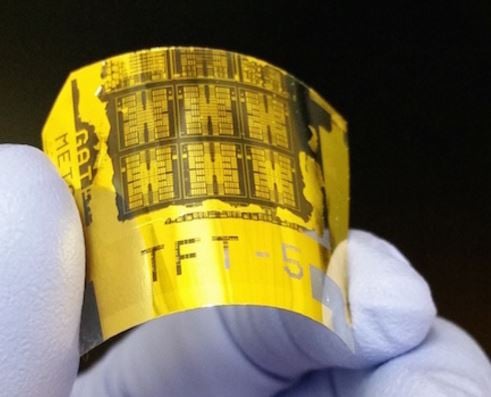A super-fast, flexible silicon phototransistor created by electrical engineers at the University of Wisconsin-Madison may dramatically improve the performance of digital cameras, smoke detectors, satellites, night-vision goggles, and surveillance systems.
The researchers say their silicon phototransistor is the fastest and most responsive ever made.
Products that rely on electronic light sensors are likely to benefit significantly from their new creation. Intergrated into a digital camera lens, for example, the phototransistor could reduce bulkiness and enhance both the acquisition speed and quality of videos or still photographs.
 This phototransistor is flexible, and also much faster and more responsive than any similar phototransistor in the world. (Image: http://news.wisc.edu)
This phototransistor is flexible, and also much faster and more responsive than any similar phototransistor in the world. (Image: http://news.wisc.edu)
Jung-Hun Seo, a research scientist, and Zhenqiang “Jack” Ma, professor of electrical and computer engineering, say the high-performance phototransistor far and away exceeds every single previous flexible phototransistor parameter, including response time and sensitivity.
Prof. Seo and colleagues published details of their research in the academic journal Advanced Optical Materials.
Turning light data into zeros and ones
As human eyes do, the phototransistors essentially sense and gather light, then convert it into an electrical charge proportional to its wavelength and intensity.
In the case of animals, including humans, the electrical impulses transmit the image to the brain. That electrical charge, in digital cameras, becomes a long string of zeros and ones that create a digital image.
While most phototransistors are fabricated on rigid surfaces, and are therefore flat, the ones made by these scientists are flexible. This means they can more easily mimic mammalian eye behavior.
Prof. Ma said:
“We actually can make the curve any shape we like to fit the optical system. Currently, there’s no easy way to do that.”
One important aspect of the new phototransistors’ success is the scientists’ innovative ‘flip-transfer’ fabrication method, in which their final step is to invert the completed phototransistor onto a plastic substrate (underlying substance). At that point, a reflective metal layer is on the bottom.
More efficient light absorption
Prof. Ma said:
“In this structure – unlike other photodetectors – light absorption in an ultrathin silicon layer can be much more efficient because light is not blocked by any metal layers or other materials.”
The scientists also placed electrodes under the ultrathin silicon nanomembrane layer of the phototransistor – and the electrodes and metal layer each act as reflectors and improve the absorption without requiring an external amplifier.
“There’s a built-in capability to sense weak light,” Prof. Ma said.
Prof. Ma, whose work was supported by the U.S. Air Force, added:
“This demonstration shows great potential in high-performance and flexible photodetection systems. It shows the capabilities of high-sensitivity photodetection and stable performance under bending conditions, which have never been achieved at the same time.”
In an Abstract in the journal, the authors wrote:
“Overall, such flexible phototransistors with the capabilities of high sensitivity light detection and stable performance under the bending conditions offer great promises for high-performance flexible optical sensor applications, with easy integration for multifunctional applications.”
The scientists are patenting the technology through the Wisconsin Alumni Research Foundation.
Citation: “Flexible Phototransistors Based on Single-Crystalline Silicon Nanomembranes,” Seo, J.-H., Zhang, K., Kim, M., Zhao, D., Yang, H., Zhou, W. and Ma, Z. Advanced Optical Materials. 26th October, 2015. DOI: 10.1002/adom.201500402.
